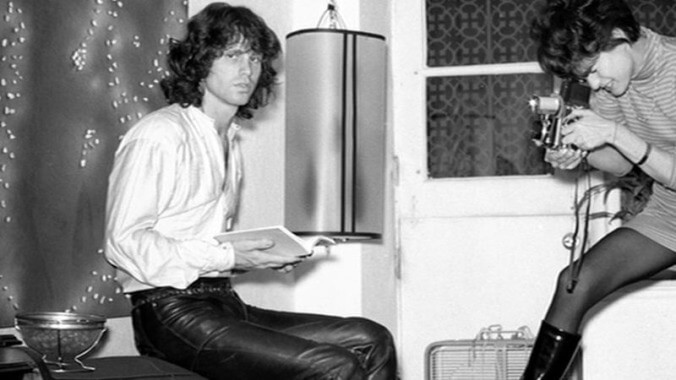As teased out in my discussion with fellow abused Doors fan Steve Hyden late last year, the self-made mythology of Jim Morrison is The Doors’ most lasting, defining aspect, and the reason so many people absolutely hate them. I could go—and have gone—on and on about the fact that Robby Krieger and John Densmore are great musicians unfairly overshadowed by their frontman, the importance of the “cult of personality” to rock music, the myriad respected artists that Jim Morrison heavily influenced, but who somehow don’t get the shit he does (like Iggy Pop, Alice Cooper, Henry Rollins, Ian Curtis), etc. But the truth of The Doors’ appeal to me is this: Jim Morrison showed all us lame suburbanite kids that reinvention is only a matter of will. After all, if an ordinary, chubby Navy brat can torch his past and remake himself as a modern-day Dionysus—or even just a leather-clad asshole drunk who wrote pretentious poetry and got laid a lot—then truly anything is possible.
The even crazier thing is, that mythology was created in a short matter of years on just a few condensed California blocks. It all started on the no-longer-so-romantic Venice Beach boardwalk, where Morrison famously camped on a rooftop overlooking the Pacific Ocean, taking copious psychedelics, and generally doing everything that sounds awesome. Then came the Sunset Strip, where Morrison—who lived only a block or so off the main drag—saw basically his entire career play out, from the early days of the band honing its material in front of bored hookers at The London Fog, to ruling the Whiskey A Go Go just down the street, to recording The Doors’ first two albums at the Sunset Sound studios. And at the top of the Strip is the 9000 Building, a monolithic slab where Morrison did his death-inviting “tightrope walk” on its ledge, and which—in an ironic counterpoint to how those sorts of stories became commodified over the years—for a long time housed The Doors’ corporate offices.
All of these places have become saddled with their own logy lore by decades of documentaries, the grandiloquent melodrama of Oliver Stone’s The Doors, and Ray Manzarek never shutting the fuck up. And truthfully, it’s entirely probable that some of their legend is just that, as not even the guys who were in the band seem to tell these stories the same way twice. But seeing in person the places at the center of the Morrison mythology only reinforces their ordinariness, and reminds you that they’re really just tiny buildings and grotty clubs where a guy with a decent baritone and a library card made himself into a worshiped, derided, endlessly debated mythic figure. Buy into it or not, it makes for a great story.


 Keep scrolling for more great stories from A.V. Club.
Keep scrolling for more great stories from A.V. Club.